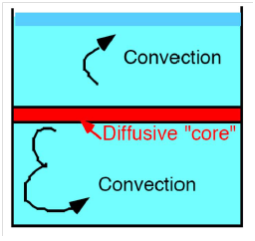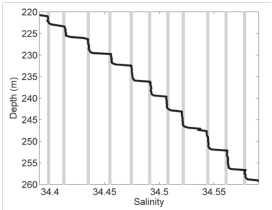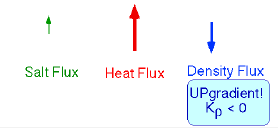Table of Contents
Double Diffusion & Salt Fingering
Author: Daniela König
Types of stratification

A & B: Diffusively stable
C & D: Double diffusion (C: diffusive convection, D: salt fingering)
E: No stratification, mixing
Double diffusion
Double diffusion occurs when temperature and salinity have an opposite effect on density, meaning that one is stabilizing and the other one destabilizing the stratification. The stabilizing component outweighs the destabilizing one so that the water column is stable and there is no convection. As the diffusion of heat is much faster than the one of salt, two different regimes occur: salt fingering and diffusive convection.
Salt fingering
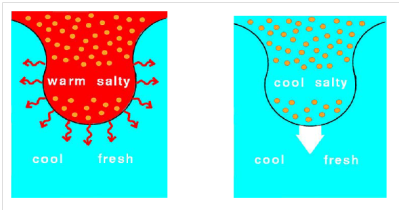
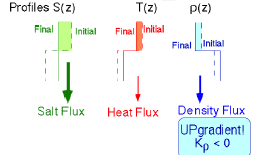
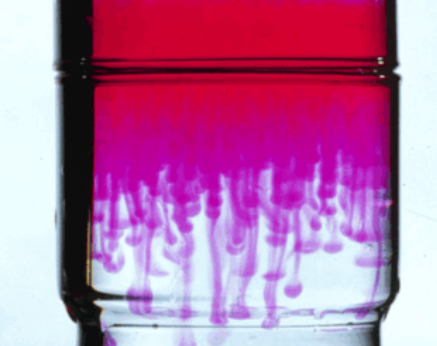 Salt fingers occur when warm salty water overlies cooler fresher water. This can take place in regions with high evaporation and surface temperature, e.g. in the tropics and subtropics. If there is a small perturbation on the interface, the water from the upper layer will lose its heat much faster than its salt content and when it reaches a higher density than its surroundings it will sink creating a “salt finger”.
Salt fingers occur when warm salty water overlies cooler fresher water. This can take place in regions with high evaporation and surface temperature, e.g. in the tropics and subtropics. If there is a small perturbation on the interface, the water from the upper layer will lose its heat much faster than its salt content and when it reaches a higher density than its surroundings it will sink creating a “salt finger”.
Diffusive convection
If cool and fresh water overlies warmer and saltier water diffusive convection takes place. This can occur in polar regions when melting ice is adding cold and fresh water to the surface or if there is a source of hot water at the bottom of the water column, e.g. below Lake Kivu.
In this case, the lower layer loses heat to the upper layer, but not much salt, so the water that reaches the interface will get denser and sink. Meanwhile, the water just above the interface gets warmer and therefore lighter and rises, so there is convection away from the interface creating a stronger stratification. Compared to salt fingering, there is no fluid exchange in this case. Because both layers above and below the interface get mixed, a “staircase” can develop, where each layer has its distinct temperature and salinity and there are sharp lines between the layers. These interfaces can produce internal waves.
References
Talley, L.D., Pickard, G.L., Emery, W.J. and Swift, J.H., 2011. Descriptive physical oceanography: an introduction. Chapter 7.4.3.2.
Münnich, M. (2014): Introduction to Physical Oceanography:Lecture 6
http://earth.geology.yale.edu/~avf5/teaching/ResourcesGG535/Lecture9.DynStability.DoubleDiffusion.pdf
Tasks
Add a section where these regimes occur in the ocean. (1 Student)
